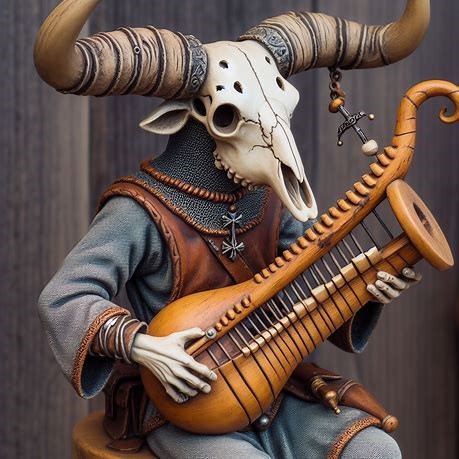Introduction
In the shadowed alleys of medieval Europe, where the echoes of war and religious fervor reverberated through the cobblestone streets, there existed an enigmatic instrument—the **Necrosinfoniumtut**. Its name whispered like a forbidden secret, and its haunting melody stirred both awe and dread. Legend had it that the player was not among the living, but a spectral figure bound to the strings of this gourd-based creation.
Origins and Construction
The “Necrosinfoniumtut” was unlike any instrument known to humanity. Its base was a hollowed-out gourd, split down the middle, its wooden ribs exposed like the fragile bones of an ancient creature. The gourd's natural resonance provided an eerie undertone, as if the very earth itself mourned through its wooden vessel.
The strings—taut and unyielding—stretched across the gourd's opening, their origins shrouded in mystery. Some whispered that they were spun from the hair of fallen warriors, while others believed they were plucked from the harp of Death itself. The long neck extended upward, adorned with intricate carvings depicting scenes of battle, salvation, and damnation.
The Faceless Musician
The player of the Necrosinfoniumtut was a phantom—a figure draped in tattered robes, its face obscured by a featureless mask. No eyes, no mouth, just an empty void where a visage should be. The mask bore the weight of centuries, etched with cryptic symbols and runes that seemed to pulse with an otherworldly energy.
The musician wandered the war-torn landscapes, haunting the camps of Crusaders and Saracens alike. When the moon hung low, and the battlefield lay silent, the Necrosinfoniumtut would emerge. Its strings, when plucked, produced a mournful dirge that transcended mortal comprehension. Soldiers huddled around campfires, their hearts heavy with fear and longing, unable to tear their gaze from the faceless performer.
The Melody of Desolation
The music of the Necrosinfoniumtut defied conventional scales. It wove through minor chords and dissonant harmonies, evoking the anguish of lost souls and the futility of war. The gourd resonated with the cries of fallen knights, the whispers of forgotten lovers, and the lamentations of mothers who buried their sons in unmarked graves.
As the musician played, the air shimmered with spectral apparitions—the fallen warriors rising from the earth, their ethereal forms swaying to the melancholic tune. The living watched in awe and terror, torn between fleeing and surrendering to the music's embrace.
The Legacy
Legends spread like wildfire. Some claimed that the Necrosinfoniumtut could sway battles, turning the tide in favor of those who listened. Others believed it was a curse—a siren's call leading men to their doom. But one truth remained: the faceless musician played on, weaving the threads of life and death into a haunting tapestry.
And so, the Necrosinfoniumtut became a symbol—an emblem of the Crusades' madness, a reminder that even in the darkest hours, music could transcend mortality. Its legacy echoed through time, whispered in forgotten ballads and etched into the annals of history.
Conclusion
The Necrosinfoniumtut vanished as mysteriously as it appeared. Some say it rests in a hidden crypt, waiting for a new age of turmoil to awaken its strings. Others claim it was never real—a figment of fevered imaginations and battle-weary minds.
Yet, when the wind howls through ancient ruins, and the moon casts elongated shadows, some swear they hear its mournful melody—a requiem for lost souls, played by a faceless musician who defied death itself.
#Necrosinfoniumtut
#MedievalMusic #Legends
*Disclaimer: The
Necrosinfoniumtut is a purely fictional creation, born from the depths of
imagination. Any resemblance to actual historical events or persons is
coincidental.
















.jpeg)
